Helen Walasek et al offer a comprehensive account of the destruction and subsequent reconstruction of Bosnia’s cultural heritage, presenting an important corrective to much wartime misinformation. Catherine Baker praises Bosnia and the Destruction of Cultural Heritage for underscoring the potency of such attacks, seeing it as an indispensable book for those studying south-east Europe, contemporary conflict and the wider politics of cultural heritage.
Bosnia and the Destruction of Cultural Heritage. Helen Walasek with contributions by Richard Carlton, Amra Hadžimuhamedović, Valery Perry and Tina Wik. Ashgate. 2015.
 The week this review was written Sarajevans marked the 23rd anniversary of the Army of the Bosnian Serb Republic’s incendiary shell attack on Sarajevo’s National Library, which destroyed most of its holdings and left the Austro-Hungarian building a burnt-out ruin. That same day, photographs appeared showing ISIS’s destruction of the Temple of Baal Shamin in Palmyra. The politics of cultural heritage echo from conflict to conflict but, as this book shows, are always grounded in the microhistories of settlements and communities where objects stand or stood.
The week this review was written Sarajevans marked the 23rd anniversary of the Army of the Bosnian Serb Republic’s incendiary shell attack on Sarajevo’s National Library, which destroyed most of its holdings and left the Austro-Hungarian building a burnt-out ruin. That same day, photographs appeared showing ISIS’s destruction of the Temple of Baal Shamin in Palmyra. The politics of cultural heritage echo from conflict to conflict but, as this book shows, are always grounded in the microhistories of settlements and communities where objects stand or stood.
This extensive study of the destruction and reconstruction of Bosnia’s cultural heritage gathers more evidence than any previous work on what was destroyed and how organisations including national/municipal authorities, religious institutions, foreign states, heritage associations and informal residents’ groups have gone about reconstruction – or sometimes obstructed it.
Helen Walasek (a heritage specialist who was deputy director of Bosnia-Herzegovina Heritage Rescue (BHHR) in 1994–98 and an associate of the Bosnian Institute in London) and the archaeologist Richard Carlton have striven to clarify the extent of wartime damage to Bosnian cultural heritage for some years, visiting Bosnia in 2000–01 to assess many less well-known sites first-hand. Their findings, and the evidence submitted to the Council of Europe and revealed during trials at the International Criminal Tribunal for the Former Yugoslavia (ICTY), inform the longest chapters in the volume.
The volume’s contributors also include the Bosnian architect Amra Hadžimuhamedović (a member of the Commission to Preserve National Monuments), the US democratisation expert Valery Perry and the Swedish architect Tina Wik, a former international member of the aforementioned Commission. Their chapters give insight into the different levels at which they each worked, with Perry explaining the implementation of the cultural heritage annex of the Dayton Peace Agreement, Wik describing Cultural Heritage Without Borders’s cooperation with the Swedish government and authorities in Bosnia and Hadžimuhamedović offering a valuable study of reconstruction in Stolac. Together, they suggest that reconstruction efforts concentrating on iconic sites are not enough. It is at less well-known ‘contentious sites’ (208–09), where refugees try to return but wartime authorities remain in place, that reconstruction can most powerfully remake communities, yet is often either left to citizens’ autonomous initiatives or prevented from taking place.
 Image Credit: Vedran Smailović playing the cello in the destroyed National Library, Sarajevo, in 1992 (Wikipedia Public Domain)
Image Credit: Vedran Smailović playing the cello in the destroyed National Library, Sarajevo, in 1992 (Wikipedia Public Domain)
The volume aims not only to record what was destroyed and (sometimes) rebuilt, but also to correct wartime misinformation which, it suggests, may continue to circulate if cited during wartime and then re-cited by later writers. The Franciscan monastery at Guča Gora and the Orthodox church of the Assumption of the Holy Mother of God in Livno were both reported as destroyed and yet were not, though both were damaged (78 and 125–42); for Guča Gora, Walasek and Carlton review evidence from ICTY cases against the Croatian Defence Council (HVO) and Army of the Republic of Bosnia-Herzegovina (ARBiH) commanders to establish who desecrated the monastery and when (a group of foreign mujahedin on 10 June 1993).
At the same time, Walasek and Carlton provide ample evidence of buildings being rooted out completely, like the historic Ottoman urban cores of Foča, Prijedor and Stolac, the city-centre mosques of Banja Luka and the mosques of many towns in north-east Bosnia, including Bijeljina, Brčko, Janja, Višegrad and Zvornik (170–74). Theirs is a study in which, as when forensic evidence records the injuries that victims of genocide suffered, the devil is in the detail. Walasek and Carlton record where buildings were razed to their foundations in the areas under Republika Srpska (RS) control and when they were left as ‘upstanding mosque shells’; how high into the hills people must have gone to tear down mosques in small mountain villages near Kotor Varoš; and how one disused mosque in Kotezi exceptionally survived, apparently because ivy had covered its ‘unique’ low minaret (176–78).
They also note the targeting of non-religious sites that testified to Bosnia’s multi-ethnic heritage through their own history or the archives they contained (thereby joining András Riedlmayer’s work on libraries); the destruction of cemeteries; and the looting of art, which was sometimes, they imply, the responsibility of organised criminals officially on the same ‘side’.
Readers are urged throughout to view the destruction of cultural heritage as a deliberate destruction of the link between peoples and the territory where they lived by removing the material objects that were simultaneously part of their everyday place-making in the present and physical evidence of their presence in the past. The volume agrees with the ICTY judges who tried Radislav Krstić that attacks on cultural heritage could be used as all-important ‘evidence of an intent to physically destroy the group’: necessary for a genocide conviction (312). (Indeed, it would probably go further; Krstić’s judges referred to attacks simultaneous with physical attacks, but this volume describes extensive destruction behind the lines in RS-controlled territory.) Certain agencies’ fear of being seen to prioritise buildings over people is therefore seen as a false choice: protecting the buildings and protecting the people would go hand-in-hand if the commitment to stop ethnic cleansing had been high enough. From Brčko and Foča, there is even evidence of rubble being used to cover mass graves (37–38).
Critical geopolitics, anthropology and other disciplines have already theorised the implications of attacks on cultural heritage. Yet this volume also makes a historiographical intervention: interpreting it as a ‘pattern of mutual and equivalent destruction’ (156) in the Bosnian case, which Carlton and Walasek read one early influential article as anticipating, is not good enough. Instead, they find the most destruction in RS-controlled territory, and enough destruction in HVO-controlled territory to also appear systematic. ICTY exhibits show Sarajevo government forces, meanwhile, both issued more orders banning troops from destroying cultural heritage and more frequently investigated incidents that did take place (62-64). Although the volume limits its scope to cultural heritage, its evidence quietly and powerfully lends support to broader works that criticise notions of false equivalence during the Bosnian war.
As the most detailed source on the destruction of cultural heritage in Bosnia, this book is an investment that institutions committed to studying south-east Europe, contemporary conflict or heritage deserve to make. It shows that perpetrators of destruction targeted sites not only because they connected territory to other ethno-religious national groups, but also for connoting a multi-ethnic tradition that itself had to be erased to create a homogenous ethnicised space. The implications of eliminating such traditions are clear from this study of Bosnia-Herzegovina and should be acknowledged again as heritage comes under attack in another part of the post-Ottoman space.
Catherine Baker is a Lecturer in 20th Century History at the University of Hull. She is the author of The Yugoslav Wars of the 1990s (Palgrave Macmillan, 2015), Sounds of the Borderland: Popular Music, War and Nationalism in Croatia since 1991 (Ashgate, 2010) and, with Michael Kelly, Interpreting the Peace: Peace Operations, Conflict and Language in Bosnia-Herzegovina (Palgrave Macmillan, 2013). Her research interests include nationalism and cultural politics in the post-Yugoslav region and elsewhere.
Note: This review gives the views of the author, and not the position of the LSE Review of Books blog, or of the London School of Economics.






